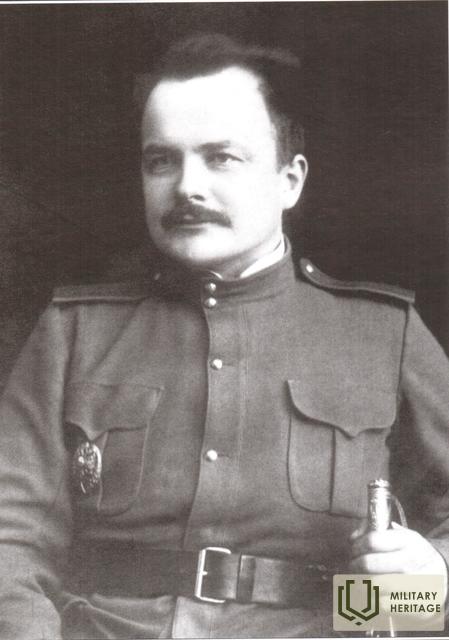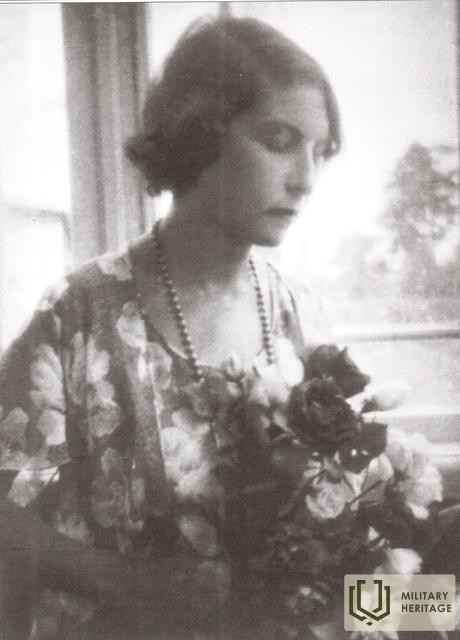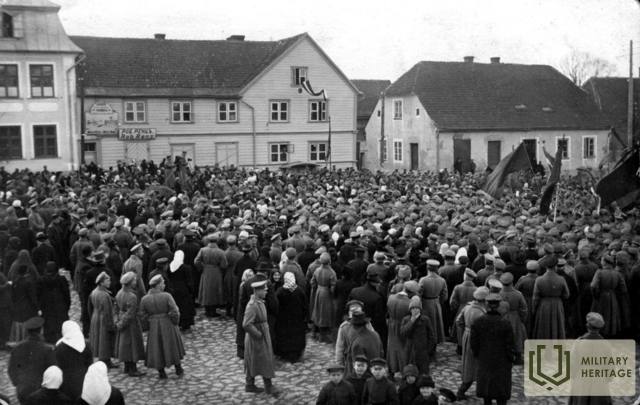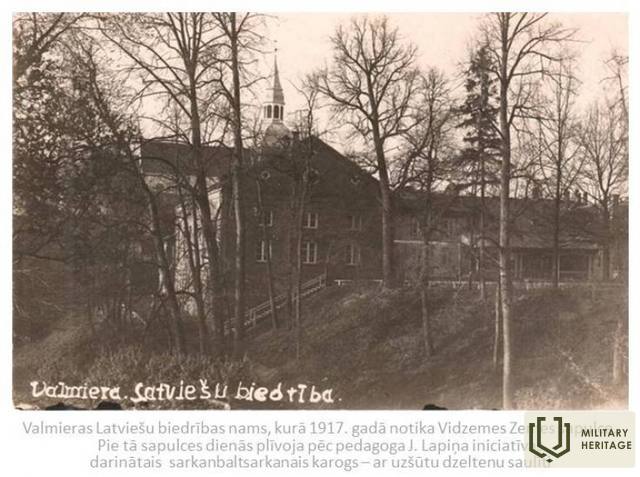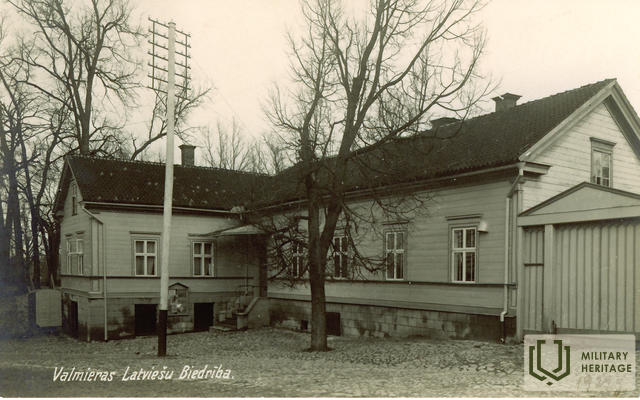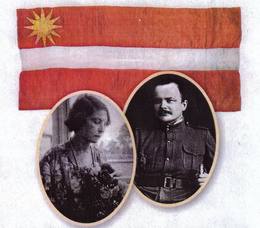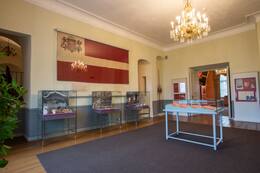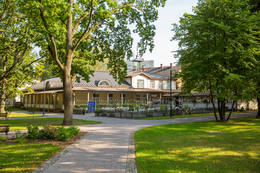Jānis Lapiņš and the first draft of the red, white and red flag of Latvia
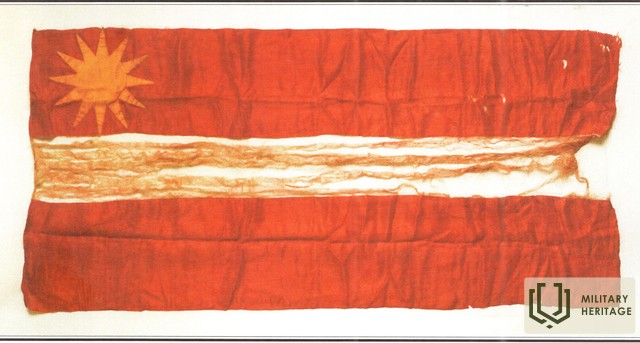
The creation of the Latvian national flag took place during the First World War. In 1915, when creating the flags of the Latvian rifle battalions, individual artists proposed red, white and red colors for the flag designs. After the design of the educator and journalist Jānis Lapiņš, the red, white and red flag was made in the second half of 1916 by his student, a teacher at the Valmiera refugee shelter, Marianna Straumane. This is the first known and actually made Latvian national flag, which has also survived to this day.
One of the most ardent popularizers of the idea of Latvian independence was the Veselava-born teacher and journalist Jānis Lapiņš (1885-1941), who worked at the Valmiera trade school since the autumn of 1915. In addition to his regular schoolwork, he had to deal with refugee affairs. The office of the refugee supply organization "Ziemeļpalīdzība" is located behind the castle ruins, in the Maršners' house, one of the best in the city. The Kurzeme refugees honored Lapiņš with great respect as a refugee officer, recalls the writer Kārlis Eliass (1899-1985), born in Kauguri parish and then a student at the trade school of the Latvian School Association: ""
Jānis Lapiņš fascinated many with the idea of the Latvian red-white-red flag. This flag was made (embroidered) for him in the second half of 1916 by Marianna Straumane (1896 -1985), a teacher at the Valmiera refugee children's shelter, who would later become J. Lapiņš's wife. In 1917, Lapiņš organized the People's University in Valmiera and participated in all the most important public events. Latvian cultural workers Jānis Akuraters, Kārlis and Lizete Skalbes, Pauls Dāle, Ernests Blanks, Linards Laicens, etc. lived or visited the teacher's house on Aleksandra Street for a longer or shorter period of time.
As a testament to the growing self-confidence of Latvians, the red-white-red flag fluttered over the Valmiera Latvian Society building during the Vidzeme Land Assembly in March 1917. One of the most ardent popularizers of the red-white-red national flag, Jānis Lapiņš, also participated in the assembly dedicated to the proclamation of the new Latvian state in Valmiera (Vecpuišu Park)! In his address to Valmiera schoolchildren, he said in picturesque language that “all the ancient dreams of the Latvian people are approaching their fulfillment, but the sunken Palace of Light must also rise.” The youth of Valmiera schools had no idea how prophetic Lapiņš’s words would turn out to be, because the declared freedom of Latvia would still have to be won!
In the 1920s and 1930s, the valuable relic was kept in the Lapiņš family, then, during the Soviet era, it was carefully hidden. During the years of German occupation, Marianna and her daughter evacuated to Germany along with the factory where they worked, taking the flag with them, of course. After the war, upon returning to Latvia, it had to be hidden for many years. In 1997, Marianna and Jānis Lapiņš's daughter Lija Poga donated this very flag, which was already more than 80 years old at that time, to the Cēsis Museum. It is noteworthy that the first flag mentioned in the chronicle was made in Cēsis in 1279 as the ideological prototype of our Latvian flag, but the first national flag was sewn and made in Valmiera in 1916.
Informative and illustrative material from Pumpuriņš T. Red, white and red – the colors of the Latvian flag. Cēsis, 2000. and the collection of the Valmiera Museum.
https://www.valmiera.lv/lv/kultura/latvijai_100_/brivibas_stasti/janis_lapins/
Related timeline
Related topics
Related objects
Memorial site of J. Lapiņš, the author of the first Latvian flag
Located in “Lejas Pintuļi”, Veselava parish, Priekuļi municipality.
A memorial to Jānis Lapiņš, the author of the Latvian flag, is visible.
The creation of the Latvian national flag took place during World War I. In 1915, when creating the flags of the Latvian rifle battalions, individual artists proposed red, white and red colors for the flag designs. After the design of the educator and journalist Jānis Lapiņš, the red, white and red flag was made in the second half of 1916 by his student, Marianna Straumane, a teacher at the Valmiera refugee shelter.
This is the first known and actually made Latvian national flag, which has survived to this day.
In 2014, a memorial site for the pre-flag author Jānis Lapiņš was opened in “Lejas Pintuļi” of Veselava parish, Priekuļi region.
The first known authentic Latvian national flag, which was smuggled into Russia and carefully hidden during the Soviet and German occupations, is currently kept in the Cēsis History and Art Museum . It was donated in 1997 by their daughter Lija Poga.
Cēsis history and art museum in the New Castle of Cēsis
The Cēsis History and Art Museum is located in the very centre of the Old Town of Cēsis, in the New Castle. The museum holds a permanent exhibit of history and interiors named ‘Cēsis, a Symbol of Latvian History’, with two thematic sections: the exhibit ‘Red-White-Red Flag in the History of Cēsis and Latvia’ explains the history of the Latvian national flag from the 13th to 20th centuries, the approved national symbol, the flags of Latvian rifle battalions and the traditions of using national colours during the Latvian War of Independence. The exhibit ‘Cēsis and the Latvian War of Independence’ focuses on the founding of the Cēsis Company in December 1918, the joint battle efforts of Estonians and Latvians in the 1919 Battles of Cēsis, the time when, during the Bermondt Affair, Cēsis served as the temporary capital of Latvia for a short time, as well as the history of the Cēsis Victory Monument. In an escape room named ‘Legends of the Battles of Cēsis’, the participants have one hour to find their way out by solving puzzles, making connections and finding hidden objects. The Cēsis Company, one of the first units of the Latvian Armed Forces, was established on 8 December 1918 in Cēsis Castle by Senior Lieutenant Artūrs Jansons. The museum’s exhibit features a memorial plaque dedicated to the Cēsis Company, unveiled on 8 December 1933 at the Cēsis New Castle, which, at the time, served as the headquarters of the 8th Daugavpils Infantry Regiment and the garrison officers’ club.
Stag Park and Concert Hall "Valmiera"
The park is located in the center of Valmiera.
In 1914, eight enterprising Valmiera residents decided to establish a park with a non-alcoholic buffet and a book table on the outskirts of the city at that time - thus began the history of the Vecpuiši Park.
The park's development work was interrupted by the First World War.
Already at the beginning of the war, a hospital for wounded soldiers was established in the pavilion hall. The second floor of the building housed the Valmiera Red Cross Committee, its central donation reception point, and a warehouse.
The Valmiera Committee was one of the most active in Latvia. In October 1914, it was in charge of 33 infirmaries with 375 beds. The Committee raised funds for the maintenance of infirmaries and the treatment of wounded soldiers, for the provision of warm linen and travel money to those who had recovered, for the feeding of wounded soldiers passing through, and also sent gifts directly to the front. One of the most active Red Cross Committee employees in fundraising was Kārlis Ulmanis (1877-1942), who later became the first Prime Minister of independent Latvia.
The history of the founding of the legendary Latvian rifle battalions is also connected with Vecpuiši Park. On August 4 and 5, 1915, a volunteer recruitment committee operated in the park, and on August 6, young soldiers were taken from here for training. Later, young men from Valmiera and the surrounding area were also taken from here many times as soldiers. During the war, various cultural and charity events were also held in the park, but all the funds raised were used to help those affected by the war.
On November 18, 1918, the national flag was raised for the first time in Valmiera as the state flag and the new national anthem “God, Bless Latvia” was played for the first time.
During World War II, the pavilion building of the Vecpuiši Park housed a hospital and riflemen were taken to battle. During the Soviet occupation, on August 12, 1940, by decision of the Valmiera City Board, the park was renamed Komsomol Park.
After World War II, the pavilion, designed by architect Freibergs, was used both as a cultural center (until 1966) and as a sports school. In the late nineties (1998), the pavilion in the Bachelor Park began to be active again.
The photographs displayed in the premises of the restaurant "Vecpuisis" show the founders of the park.




